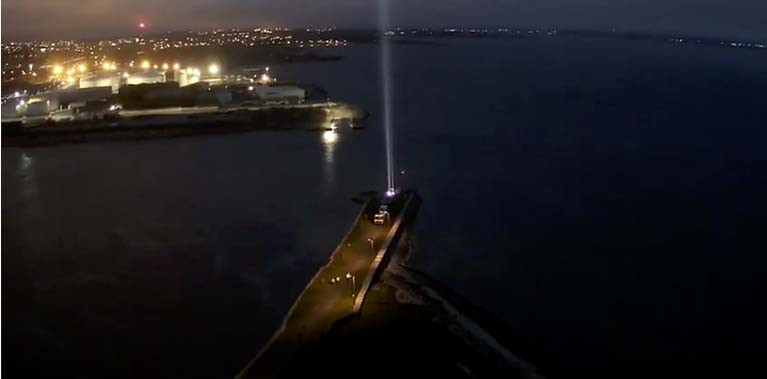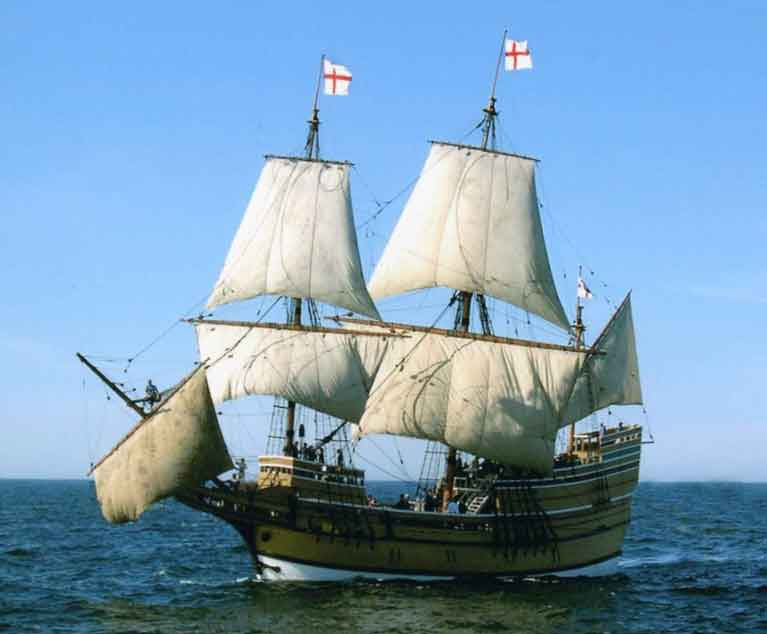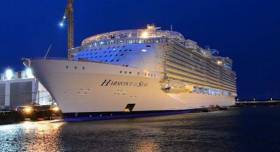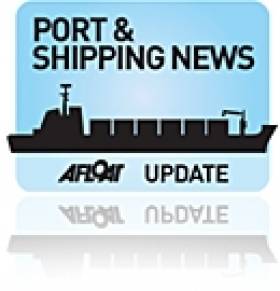Displaying items by tag: Port
'Port Pilots are National Assets' - Galway Harbourmaster
The unsung role of port pilots has been highlighted by the COVID-19 pandemic, according to Galway harbourmaster Capt Brian Sheridan.
“Without the pilots, everything would stop - they really are a national asset,” Capt Sheridan has said.
Capt Sheridan was commenting as he confirmed that key supply lines are being kept open by ports during the pandemic.
"Without the pilots, everything would stop"
He said there had been an overwhelmingly positive response to the light beamed from Galway city’s Nimmo’s pier last weekend as part of the Shine-A-Light initiative broadcast on RTÉ television.
An aerial view of the beam, and of the illuminated port and city, was filmed by Electric Skyline (see vid below)
If Your Port’s Name is Attached to a Sailing Event, Make Sure to Keep That Link Alive…
Some sailing events capture the popular imagination, while others – for some reason – simply pass by relatively unheeded. Either way, there’s no doubting that the 628-mile Rolex Sydney-Hobart Race is in the former category, with its crazy Christmas-time start witnessed by as many as 600,000 people, watching the inevitable flotilla of over-the-top SuperMaxis weaving their way out of the superb harbour at the head of an exceptionally varied and historic fleet.
It was going to be special in this year of all years, for 75 years is a long time in terms of Euro-centric Australian history. Of course, there were people in Australia for tens of thousands of years before the Europeans arrived. But like the early pre-Spanish discoverers of the Canary Islands, those First Australians who did manage to get safely ashore – for many didn’t make it – gradually abandoned any thought of seafaring as they worked out ways of making a living entirely on land from this very strange place they’d stumbled upon.
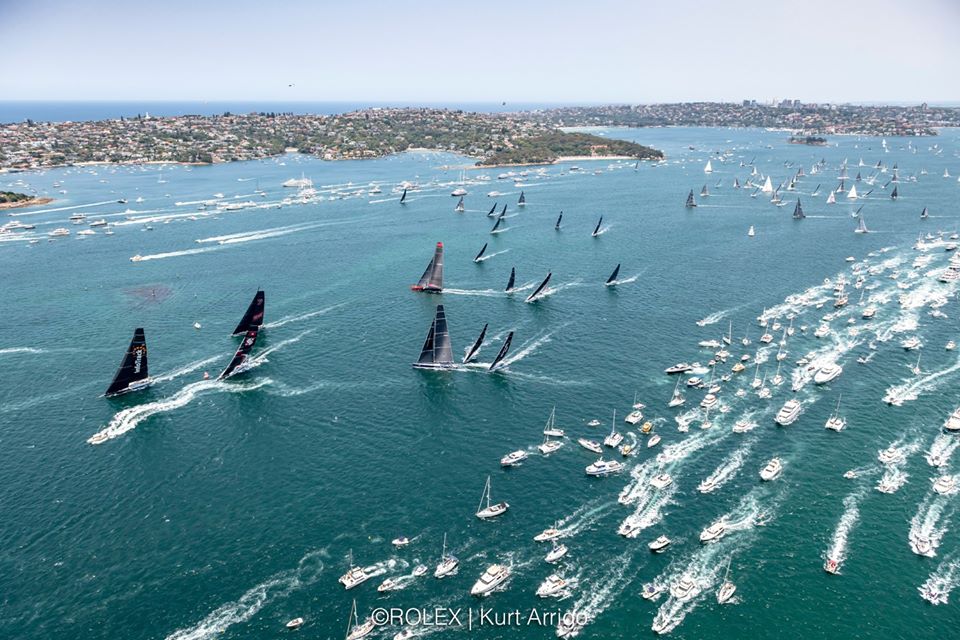 The big boats get away from the Sydney haze at the start on Thursday. Photo: Rolex/Kurt Arrigo
The big boats get away from the Sydney haze at the start on Thursday. Photo: Rolex/Kurt Arrigo
But for the new Australians from Europe, seafaring with its communication to the outside world was essential. Yet their distance from that world meant they developed their own ways of doing things, with the betting-mad Sydney Harbour 18-footers the ultimate sailing expression of the sports-oriented Australian way of life.
This year, the Sydney-Hobart has taken on added significance, for since August, Australia has been fighting a growing – and sometimes tragically fatal - battle with bush fires. The Lucky Country has been out of some of its luck, and it’s arguable that this loss of luck has been partly self-inflicted. But no country in the world can claim innocence in the causes of climate change, yet it’s Australia’s misfortune that the bush fires after years of drought should so markedly impinge on the Australian way of life, with its outdoor emphasis.
The Sydney-Hobart Race is a chance to show that life goes on, albeit in a wiser frame of mind. All it needed on December 26th 2019 was a decent onshore breeze to restore Sydney Harbour to its clear and sunny self, and a fleet which acknowledged that times aren’t quite normal, but life must go on.
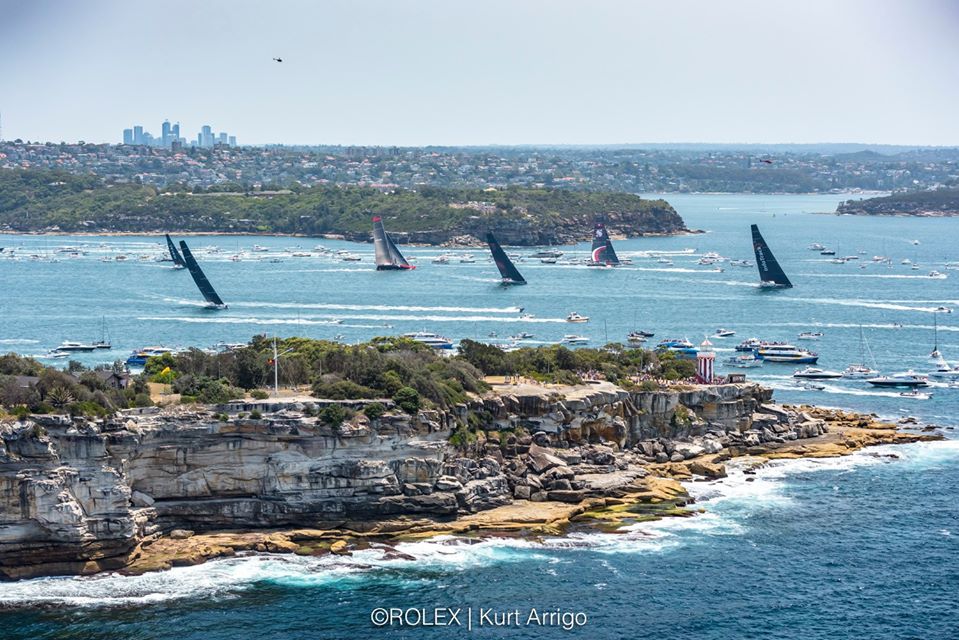 The SuperMaxis heading into open water on Thursday – the size of the spectator fleet, plus tens of thousands of watchers ashore, spoke volumes for how much the successful staging of the 75th Rolex Sydney-Hobart Race meant to Australians in these challenging times. Photo: Rolex/Kurt Arrigo
The SuperMaxis heading into open water on Thursday – the size of the spectator fleet, plus tens of thousands of watchers ashore, spoke volumes for how much the successful staging of the 75th Rolex Sydney-Hobart Race meant to Australians in these challenging times. Photo: Rolex/Kurt Arrigo
And it certainly is a life-affirming event, one of sailing’s great spectacles, yet one in which every boat in the fleet from 30 footers to 100 footers feels equally involved. Having been inaugurated in 1945 under the inspiration of that remarkable offshore racing pioneer John Illingworth, it soon seemed the most natural thing in the world to race from Sydney to Hobart, for an annual cruise-in-company along the same route was a Christmas tradition at the Cruising Yacht Club of Australia.
Today, Sydney-Hobart as a brand name has real muscle, and while Sydney has always basked in its association with the race’s start, it took the more conservative Hobart rather longer to realize that this sporting special gave them a USP in the Tasmania-promotion stakes for tourism.
 Hobart in Tasmania – it’s the same latitude as Bordeaux in France
Hobart in Tasmania – it’s the same latitude as Bordeaux in France
In fact, interest is at an all-time high, for last year for the first time a Tasmanian boat was the overall winner, Philip Turner’s RP66 Alive. It’s as though a Wicklow boat had won the Round Ireland Race…… And these days, those who had thought Tasmania was a remote and windy island somewhere down towards the Antarctic are now aware that Hobart in the Southern Hemisphere is on the same latitude as Bordeaux in the Northern Hemisphere, and it’s a charming and scenically stunning place with its own remarkable classic yacht tradition.
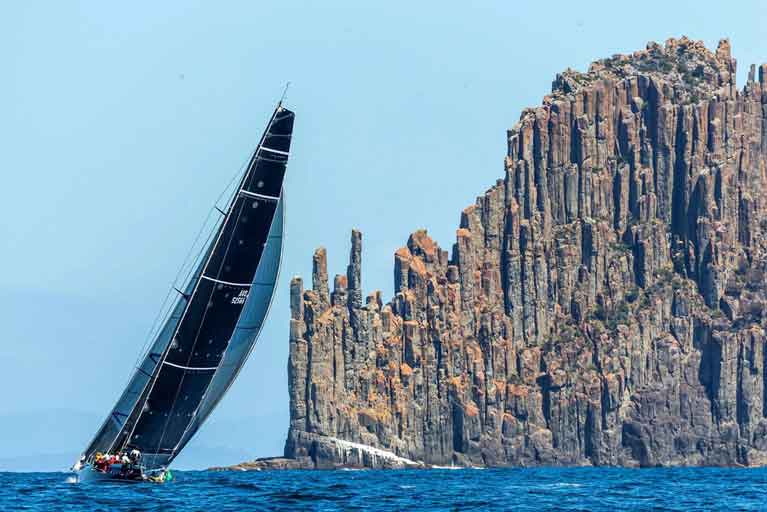 The Tasmanian RP 66 Alive weathering the famous Organ Pipes in the approaches to Hobart, on her way to the overall win in the 2018 Rolex Sydney-Hobart Race. Photo: Studio Borlenghi/Rolex
The Tasmanian RP 66 Alive weathering the famous Organ Pipes in the approaches to Hobart, on her way to the overall win in the 2018 Rolex Sydney-Hobart Race. Photo: Studio Borlenghi/Rolex
Thus the message is that if you’ve got your port associated with a great sailing event which has popular interest, for heaven’s sake do everything you can to nurture the relationship. In following the Sydney-Hobart Race’s fascinating progress with its often extraordinary yet time-honoured finish totally identified with Hobart, it’s a reminder that just a month ago, the world of offshore racing – indeed the world of sailing globally – was agog at the news that the biennial Fastnet Races of 2021 and 2023 would not finish at Plymouth in Devon - as the race had done since its inauguration in 1925 - but instead would finish in Cherbourg, where the local authorities were prepared to be lavish with their preparations and welcome.
The people of Plymouth must think the fates have got it in for them. The historic harbour, associated with the swashbuckling if sometimes very questionable wealth-enhancing seafaring deeds of the likes of Drake and Raleigh and Hawkins, has been seeing its more modern maritime links greedily challenged by other ports.
As Shakespeare observed in another context in the time of those energetic opportunists: “When sorrows come, they come not single spies, but in battalions”. For Plymouth, it was only starting when it was announced back in May that an alternative OSTAR (the original single-handed Transatlantic Race first staged from Plymouth’s Royal Western YC in 1960) was going to have a highly-funded re-birth from Brest in France.
 The Port of Plymouth, which has hosted the finish of every Fastnet Race since 1925. But for 2021, the finish will be in Cherbourg
The Port of Plymouth, which has hosted the finish of every Fastnet Race since 1925. But for 2021, the finish will be in Cherbourg
That announcement didn’t come from Plymouth. It emanated from OC Sport, who have rights in the race and are based in Cowes, but have been majority French-owned since 2014. Meanwhile, Plymouth is going ahead with its own 60th Anniversary OSTAR (Original Single-Handed Race) on 10th May.
For the mega-funded hyper-publicised French super-multihulls, the offering from Brest has obvious appeal. But the historical claims of Plymouth are likewise gaining their adherents, and as entries don’t close until 16th March 2020, the evolving story of the two races is continuing.
Then in late November, with just ten days to go until December’s Paris Boat Show with its potential to give significant upcoming events a fresh buzz of publicity, it was announced that the RORC Rolex Fastnet Races of 2021 and 2023 would not be finishing in Plymouth - as the race has done since it was founded in 1925 – but instead, in a course 90 miles longer, the finish would be in facility-filled money-waving Cherbourg in France.
The reactions to this have been spread right across the entire spectrum from complete disapproval to enthusiastic support, and even now it’s still simmering.
At the apparently rather sparsely attended but online-streamed press conference in RORC HQ in London, the top honchos did reveal that for the Centenary Fastnet Race in 2025, they might consider returning to Plymouth if berthing facilities has been markedly improved.
In the circumstances, it sounded slightly patronizing with an unpleasant whiff of the wheeler-dealing about it. But we can soften their cough by pointing out that if they really want a truly authentic Centenary Fastnet Race in 2025, then they’ll have to abandon the Cowes starting line, and instead start the fleet eastward out of the Solent from the Royal Victoria Yacht Club in Ryde. Back in 1925, the big clubs at Cowes declined to get involved in this crazy new venture. But once it was clear that it was established and would happen again, it was a case of Hello Cowes, Goodbye Ryde…….
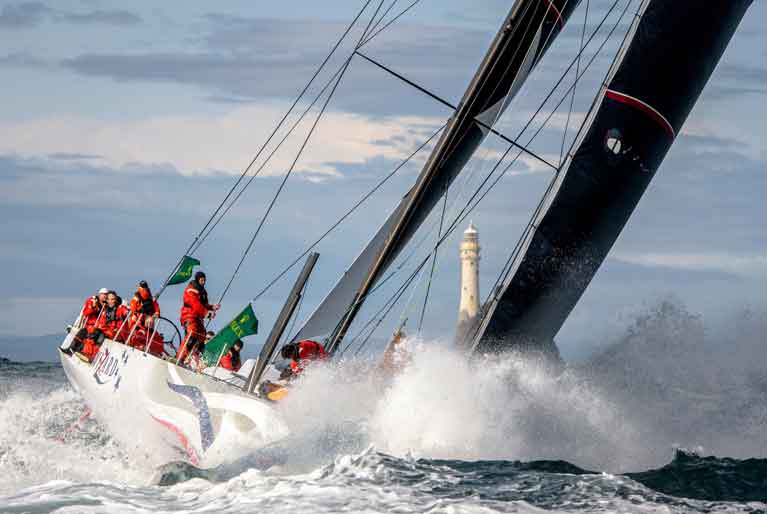 Wherever the Fastnet Race starts or finishes, it will still have to go round Ireland’s most famous rock. This is the American former Volvo 70 Wizard (David & Peter Askew), winner of World Sailing’s “Boat of the Year 2019” title, at the Fastnet Rock on her way to winning the Rolex Fastnet race 2019. Photo: Rolex
Wherever the Fastnet Race starts or finishes, it will still have to go round Ireland’s most famous rock. This is the American former Volvo 70 Wizard (David & Peter Askew), winner of World Sailing’s “Boat of the Year 2019” title, at the Fastnet Rock on her way to winning the Rolex Fastnet race 2019. Photo: Rolex
No matter what they do, Ireland’s impregnable Fastnet Rock remains immovably at the heart of it all. It is simply The Fastnet Race – full stop. But back in Plymouth, yet another historical challenge to their cherished maritime perception of themselves arose at the end of November. For they’d been thinking that, regardless of what might happen to the OSTAR and the Fastnet Race, the really big deal in their maritime history is their link to the Pilgrim Fathers sailing in the Mayflower from Plymouth to America in 1620.
Now there’s an anniversary to conjure with. 400 years to be celebrated in Plymouth in 2020 for something which has pure gold historical importance. But the people of Harwich on England’s East Coast say that Plymouth’s claims to the Mayflower story are only incidental. The ship began her voyage from the East Coast, they say, and only called briefly at Plymouth while heading west.
To underline their case, they’ve spent 2019 restoring the house in Harwich which was the home of Christopher Jones, Captain of the Mayflower, and in 2020 they look forward to greeting thousands of American visitors to Mayflower’s most tangible and authentic link.
And to the west of Plymouth, the people of the fishing port of Newlyn in Cornwall are also claiming that the Mayflower actually stopped there - albeit briefly – before the real beginning of the Transatlantic voyage, so that’s where the American tourists should be splashing their dollars.
Quite so. It would be time for the people of Plymouth to send for Francis Drake and his more ruthless shipmates to sort this out were it not for one indisputable geographic and historical fact. The place where the Pilgrim Fathers first landed in America in December 1620 is now known as Plymouh Rock. It is in Plymouth, Massachusetts. Harwich? Newlyn? Fuggedaboudit……..
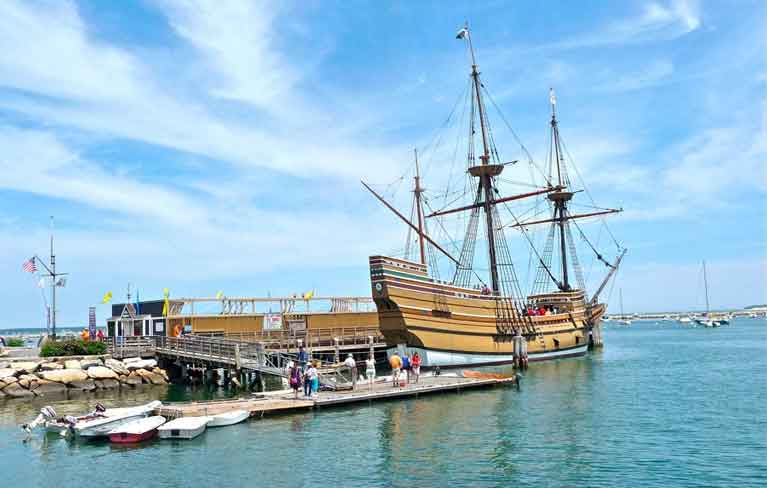 An inescapable fact of history and geography – Mayflower II berthed at Plymouth, Massachusetts.
An inescapable fact of history and geography – Mayflower II berthed at Plymouth, Massachusetts.
Meanwhile, Hobart and Tasmania have literally shaken off their links with a dismal penal colonial, past, and the place is re-born as a destination for the discerning, with a pleasant climate, fantastic scenery, and some great sailing people who can count winning the Sydney-Hobart race among their achievements. There’s no way they’re going to allow that particular link to be broken.
Should an Irish Port Be Designated As A Cruise Ship Base?
It is my belief that there is a ‘Family of the Sea,’ a community of interest uniting maritime people, from those engaged in the sector professionally, to those who take part in marine leisure activities. Bonding these disparate interests together through a focus on the sea and the Irish coastline, the rivers, the lakes, the thread linking to the oceans of the world and what happens on and in them is what I try to do in each fortnightly edition of my THIS ISLAND NATION radio programme. Listen to the podcast below.
When I am preparing the programme, recording interviews, arranging reports, I try to keep this focus which, I hope, results in an interesting half-hour voyage around the maritime sphere of Ireland. It is also why the programme is broadcast here on the AFLOAT website and through community stations which are the voices of local communities and their interests in the maritime sphere. This continues to develop, expanding this ‘community of interest’ which is what I hope to see evolve and is underlined in this new edition of the programme when the head of a company which has been providing travel at sea for over 150 years suggests that an Irish port should be designated as a base for cruise ships. George Barter leads J. Barter Travel and says that the popularity of cruise ship holidays makes this a reasonable possibility.
There would be a lot of competition for that role – including from Dublin, Dun Laoghaire, Waterford, Cork and Galway. Interestingly, Dublin Port has set up its own cruise development and marketing agency, called ‘Cruise Dublin,’ which it says is intended “to grow Dublin as Ireland’s premier cruise port.”
George Barter made the suggestion during a discussion about the popularity of cruise ship holidays, following sea trials of the biggest cruise vessel ever built - the Harmony of the Seas for Royal Caribbean Lines. The trials were conducted off the French coast, where the vessel was built at the STX shipyard in Saint-Nazaire. It cost €800,000 and is so big that it is 167 feet taller than the Eiffel Tower. It has a capacity for 6,000 passengers, 16 decks and needs 2,000 crew. That is 8,000 people aboard one vessel. It is so big that, on its first voyage from Southampton due to take place in May, passengers will be given GPS-style wrist ‘trackers’ to locate their cabins! I talked to George Barter on the programme about why cruise ships are so popular?
There is always something unusual about the sea. For example, the mysterious, green-eyed fish pulled out of Nova Scotia waters and described as a “terrifying 'alien fish' with wings and glowing eyes." The photograph here is by fisherman Scott Tanner who described it as “downright bizarre” - Three feet long, with a long, narrow tail, two prominent fins, a long pointy mouth, nose and teeth and glowing green eyes. You can hear more about it on the programme and that is it not an alien, but has been identified as a rarely seen ‘Knifenose Chimaera,’ a species which swim along the ocean floor, using that long nose to detect the heartbeats of its prey and those long, pointy teeth to dig into the ocean floor to catch them. They are so rare that very little is known about them.
There is also a very special piece of music about the RNLI on the programme. Listen and hear how you can support the lifeboat service through this special composition which remembers Lifeboat Heroes.
if you would like to contact the programme, the Email address is: [email protected]
President Higgns Signs Harbours Bill into Law, Regional Ports Transfer to Local Authorities
President Higgins signed the Harbours Bill into law on Christmas Day, the first time a President has signed legislation in to law on that day.
The Harbours bill provides the necessary legal framework for the transfer of certain ports in Dun Laoghaire, Drogheda, Galway, New Ross, and Wicklow to local authorities.
President Higgins also signed four other Bills on Christmas Day such is the haste at which the government is signing legislation before next year's General Election, according to Michael O'Regan in today's Irish Times here.
Read also: Regional Ports Move to Local Authorities in 'Radical Overhaul' of Port Sector
#tunisiasuperyacht – One week since the world was left shocked at the news of an ISIS terrorist attack in Tunisia, local superyacht businesses are reassuring yachtsmen that security has been increased at Tunisian ports despite numerous cancellations.
Not long after the country has had to recover from the impact of the Bardo Museum attack where 17 were left dead, a total of 38 people, including at least 29 Britons were killed by a gunman with links to Islamic State extremists near Sousse, Tunisia.
Despite the upped security and the government's involvement, The UK Foreign Office has updated its travel advice to warn that further terrorist attacks in Tunisia are possible and are urging people to be vigilant. According to some local yacht businesses, superyacht owners, crew and charter companies are already cancelling their travel plans.
Kim Williams from Yacht Services Tunisia explained, "The management and staff at Yacht Services Tunisia will continue to support yachting tourism by 'riding out' this horrific incident, the same way we did during the Tunisian revolution; by re-assuring yachtsmen and their yachts that security has been greatly increased in Port Bizerte and Port Yasmine.
"The Tunisian people are deeply shocked and sickened by what has happened in their country and I want people to understand that the mentality of the attacker is not Tunisian."
Imed Mzoughi, port director from Port Yasmine also commented, "At this moment in time, we have only had a 3% cancellation rate since the attack. However, we have had very little new reservations, or let's say, we haven't had any more at all. The government and the marina have enforced measures to protect the marina and surrounding areas in a bid to save the rest of the season."
A meeting between Tunisian officials and EU ambassadors is likely to take place in the coming weeks, whereit is expected a request for more intelligence-sharing and electronic monitoring equipment will be made.
Dun Laoghaire Harbour Company Unveils Cruise Berth Plans
#dlharbour – Dun Laoghaire Harbour Company has unveiled a proposed €18m plan to facilitate some of the world's biggest cruise liners inside the harbour walls. A Public consultation will open on the plans for the new cruise berth facility next Monday.
The ambitious new plan is to regenerate the harbour following the loss of the HSS Stena car ferry between Dun laoghaire and Holyhead in February. There is currently no commerical traffic coming in or out of the harbour but a total of 22 cruise ships are expected at the harbour this Summer, bringing up to 100,000 passengers and crew to the east coast port.
The development of the new cruise berth facility is essential to allow to build on the success to date to bring even more vessels and passengers, according to the harbour company, a state owned commerical entity.
The plan will involve the construction of a new quay wall and dredging of the harbour to facilitate ships up to 300 metres in length, (twice the length of the former HSS ferry) which cannot be currently accomodated anywhere else in Ireland other than Cobh in Cork Harbour on the South coast.
The plan is being unveiled this week to harbour and town interest groups including yachts and boat clubs and sailing schools over the course of 20 presentation meetings, according to Afloat.ie sources.
A new 435–metre quay wall be built in the middle of the harbour in front of the east marina breakwater to facilitate cruise ships.
If the plan goes ahead the expected construction period is expected to take 15-18 months. Dredging is expected to be to a depth of 10.5 metres to accoomodate the massive ships.
Members of the public and harbour stakeholders are being invited by the Dun Laoghaire Cruise Stakeholder Group to submit their views on plans for the development.
The two week public consultation process will open next Monday (30.03.2015) and is being launched in advance of an expected planning application to An Board Pleanala for the project. The planning application will be made by Dun Laoghaire Harbour Company on behalf of the Dun Laoghaire Cruise Stakeholder Group.
The cruise industry is an important and growing sector of the tourism market. Cruise ships are getting bigger in size, offering more facilities to passengers, but requiring deeper water and longer berths of accommodate them. Over 50% of new ships currently on order are over 300m in length. At present Cobh is the only port in Ireland that can accommodate these vessels. If facilities are not put in place, Ireland risks losing out on the expanding cruise tourism market.
Under the Planning and Development Acts, the cruise berth facility is regarded as strategic infrastructure and the planning application must therefore be made to An Bord Pleanala. It is expected that a finalised planning application and Environmental Impact Statement will go to An Bord Pleanala the end of April / early May 2015. Responses from the public and stakeholders during the consultation process will be taken into account when finalising the application to An Bord Pleanala. When the final application goes to An Bord Pleanala, observations and submissions may be made by members of the public and certain statutory bodies.
Speaking in relation to the launch of the consultation process, Gerry Dunne, CEO of Dun Laoghaire Harbour Company said: "The Dun Laoghaire Harbour Masterplan, published in 2011, identified the need to develop strategies to ensure the long term future of the harbour, in view of the declining importance of ferry traffic. Development of cruise business was identified as one of the opportunities to be pursued. In addition, Dun Laoghaire is designated as a marine tourism port under the Government's National Ports Policy and the development of the cruise business fits into this framework.
"Dun Laoghaire will have its most successful cruise season ever in 2015, with a total of 22 ships expected, bringing up to 100,000 passengers and crew to the harbour. However the development of the cruise berth facility is essential to allow to build on the success to date and to bring even more vessels and passengers to our town.
"The expansion and development of the cruise business offers significant economic benefits to Dun Laoghaire and the surrounding areas. These would include expenditure by disembarked passenger and crew; payments to tour operators by cruise companies and purchases by cruise ships from local supplies while in harbour.
"This is a hugely exciting project for Dun Laoghaire and the members of the Cruise Stakeholder Group are anxious to hear the views of the public before finalising our application to An Bord Pleanala. Full details of the proposals will be available on the Dun Laoghaire Harbour Website from Monday next at www.dlharbour.ie.
Irish Maritime Industry Leaders Gather for the First Time At Cork Forum
#maritime – The first ever Irish Maritime Forum was held today (Friday, 26th September 2014) in Cork's City Hall. Hosted by the Port of Cork, in partnership with the Irish Ports Association, the forum was attended by over 150 delegates from across the maritime industry.
Entitled 'Developing the Dynamic Future for Ireland's Maritime Sector', the forum focussed on the challenges and opportunities faced by those operating within the maritime sector, both in Ireland and in Europe.
Opening the conference, Minister Sean Sherlock TD spoke of the importance of ports as strategic points for trade growth, both nationally and internationally. He highlighted the Port of Cork and other Irish ports as global benchmarks and commended them for their future vision.
Guest speakers at the forum included Vincent De Saedeleer, Vice President of the Port of Zebrugee; Mr Alan Gray, Managing Director of the Indecon International Consulting Group; Captain Fredrik Van Wijnen, General Secretary of the Confederation of European Shipmasters' Associations (CESMA), Isabelle Ryckbost, Secretary General of the European Sea Ports Organisation (ESPO) and Patrick Verhoeven, Secretary General of the European Community Shipowner's Association (ECSA).
Speaking at the forum, John Mullins, Chairman of the Port of Cork, said: "I am delighted to be opening the inaugural Irish Maritime Forum here in Cork. This is a unique opportunity for industry leaders to come together and develop ideas for change. These ideas need to be put to policy makers to shape future government policy for the sector and I hope that is something that we can achieve here today".
Brendan Keating, Chief Executive of the Port of Cork continued, "We know that ports are a key element for national economic growth, particularly as Ireland emergences from recessionary times. However adequate port infrastructure is critical for future growth."
The forum will continue throughout the afternoon and will culminate with a gala dinner also in City Hall for over 200 guests.
Minister for Transport, Tourism & Sport Leo Varadkar has published his priorities for 2014 with a number of marine targets on his list. Varadkar wants to transfer of some ports to local authority control, and in changes to the Merchant Shipping (Registration of Ships) Bill, there are proposals to introduce a level of boat registration for leisure craft.
After a busy year for the Coasty guard in 2013, the Minister has also said he wants to develop and implement a 'Safety at Sea' strategy to reduce the number of marine fatalities and casualties.
"This year my focus is on developing new projects across all three areas of Transport, Tourism & Sport, while consolidating progress already made. Priorities include starting work on the Gort-Tuam motorway, targets to increase the use of public transport, reducing road fatalities, and moving Luas Cross City in Dublin to full construction stage.
"In tourism, we will build on The Gathering and focus on increasing visitor numbers to Ireland by 4%, and tourism revenue by 8%. There will be a strong focus on sports tourism and outdoor tourism with the Giro d'Italia, Croke Park Classic and the Wild Atlantic Way. I will also publish new tourism and aviation policies.
"The foundations will be laid for our bid for the Rugby World Cup. Work will start on the National Indoor Arena at the National Sports Campus in Dublin, and we will publish a new Masterplan for Sport. Other key projects include finalising the merger of Shannon Airport with Shannon Development, and the NRA with the RPA. Most importantly, there will be a renewed focus on road safety, and we will also start testing new roadside drug testing equipment."
Priorities for 2014
Contribute fully to the Government's efforts to reduce the deficit, generate economic growth and increase employment;
Publish new Tourism and Aviation policies and begin work on a Masterplan for Sport;
Publish/Enact the following legislation:
Vehicle Immobilisation (Clamping) Bill,
State Airports (Shannon) Bill,
Roads Bill (NRA/RPA merger),
Sport Ireland Bill,
Harbours Amendment Bill (transfer of ports to local authority control),
Merchant Shipping (Registration of Ships) Bill.
Lay the foundations for a bid for the Rugby World Cup;
Develop and implement a 'Safety at Sea' strategy to reduce the number of marine fatalities and casualties;
Renew focus on Road Safety to reduce the number of deaths and serious injuries in 2014 including the enactment of the Road Traffic Bill and the introduction of equipment to enable roadside testing for drivers under the influence of drugs;
Increase the number of overseas visits to Ireland by 4% and revenue by 8%;
Commence works on the Luas Cross City Project and ensure that disruption in the City is well handled and minimised in so far as possible;
Construction to begin on Gort-Tuam Motorway and progress the next bundle of PPPs to tender (Wexford);
Work with NTA, CIE, Luas and other transport operators to increase the number of people using public transport by 2% ie 5 million passenger journeys;
Provide support for a number of flagship Greenways;
Review the National Cycle Policy Framework;
Develop and promote the Wild Atlantic Way at home and abroad;
Make new allocations for facilities and equipment under the Sports Capital Programme;
Develop facilities at the National Sports Campus including the commencement of work on the National Indoor Arena;
Finalise the implementation of the new Rural Transport Programme with the establishment of 18 Transport Coordination Units co-located with local authorities;
Commence the Taxi Regulation Act in conjunction with adoption of implementing regulations by NTA;
Implement the recommendations of the Speed Limits Review;
Launch an online facility for Road Haulage Operator Licence applications;
Develop a road charging scheme for HGVs;
Publish a Roadmap for the transition of transport to a low-carbon future and a Strategic Framework for Investment in Land Transport ensuring that priorities for future capital investment are evidence-based;
Provide City Bikes in Cork, Limerick and Galway;
Extend the LEAP card to Cork and Galway;
Map the future development of Rosslare Port.
Irish Shipping & Port Activity Rose Up 11% – iShip Index
#shipping – Irish shipping and port activity rose up 11% in the second quarter of 2013 when compared to the corresponding period of 2012, according to the latest quarterly iShip Index and quarterly traffic review published today by the Irish Maritime Development Office (IMDO). The iShip index was at 880 points equalling its highest level since 2008. The latest analysis also indicates that four of the five principal domestic freight segments grew in the second quarter of 2013.
A large share of the growth in the last quarter has been driven by demand in the dry bulk sector which has been the strongest performing freight segment over the last three quarters, growing by 26% to 4.08 million tonnes in Quarter 2. Dry bulk shipments, typically grain, agricultural products and aggregates, make up the largest volume weighting of the iShip Index. Dry bulk commodities, such as coal, animal feed and fertilizers, all showed increased volume imports at Irish ports during the second quarter.
Roll on/roll off trailer volumes increased by 8% to 229,772 units. The majority of roll on/roll off traffic moves between Ireland and Great Britain, our largest trading partner. This trade grew by 6% as demand conditions in the UK improved. The latest economic data for the UK shows signs of a recovery which has translated into improved freight market conditions over the summer months. The rise in this sector was also helped by a stronger performance in direct continental volumes (up 26%) which were also boosted by additional vessel capacity on some of the direct continental routes earlier this year.
Container traffic (lift on/lift off) fell by 1% to 147,203 units. This sector is a key distribution channel for Irish exports and imports to long-haul markets, including Asia and the US, as well as Europe. Exports, as a subset of the total container volume, were flat as global economic conditions continued to impinge on demand. Nevertheless, strong volumes were reported in the export of meat and dairy products.
Elsewhere, imports of petroleum based commodities in tanker vessels for use in the domestic market increased by 4% to 2.58 million tonnes. Break bulk, which is largely weighted towards imports of construction related commodities, increased by 7%.
#GALWAY HARBOUR - Galway Harbour management are looking forward to the prospect of Chinese investment in the port's redevelopment plans, the Galway Independent reports.
“Chinese investors clearly recognise not only the massive potential of ocean tourism, but also the specific potential for Galway as a destination port for cruise liners," said Fine Gael TD Brian Walsh, referring to discussions between the Government and Chinese officials in Beijing last week.
As previously reported on Afloat.ie, Galway Bay can expect to welcome at least nine cruise visits thus year, with the first scheduled to arrive late next month.
Walsh added: "Galway is an incredibly attractive city, and if we can make it accessible to the major players in the cruise-line market, the impact on the local economy would be immense.”
Galway Harbour Company CEO Eamon Bradshaw said that the port project had "illicited quite a bit of interest" when the company presented at the recent Chinese-Ireland Relations conference at NUI Galway.
"We’re confident that we do have a lot to offer and we are confident that an investor will come on board."
The Galway Independent has more on the story HERE.



























